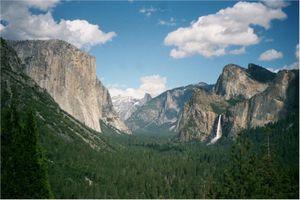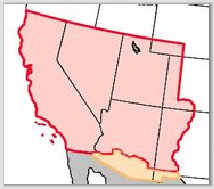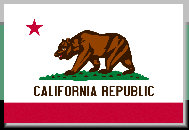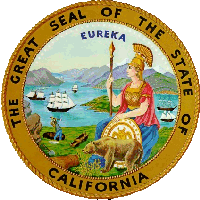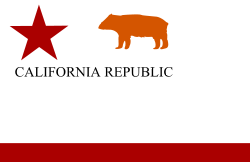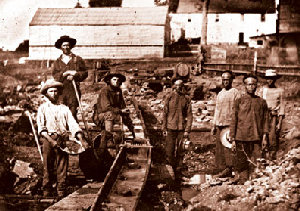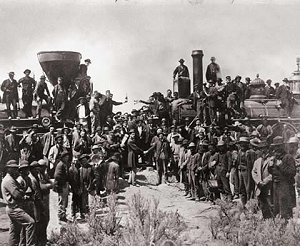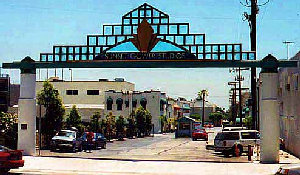The Republic of California
After Mexican independence had been won in 1821, Californios continued to feel neglected by the Mexican government as they had been
under Spanish Rule. In California, the political question revolved around declaring independence for California.
In both
1835 and 1845, the United States
offered to purchase California. In 1845, President Polk sent diplomat John Slidell to Mexico
City in an attempt to purchase the Alta California and Santa Fe de Nuevo Mexico territories from Mexico. The U.S. government
wanted to thwart British ambitions in the area.
In 1835,
Texas declared independence from Mexico and Santa Anna led his army
in to crush the rebellion. In 1846, the ideology of Manifest Destiny and the occupation of disputed territory dispute over the United
States annexation of Texas led the United States to initiate the
Mexican-American War. The United States declared
war on Mexico, May 13, 1846.
There were no civil war battles fought in California, but as a free state, California Volunteers did fight on the Union side. California's
involvement in the
American Civil War included sending gold east, recruiting or funding a limited number of combat units, maintaining
numerous fortifications, and sending east some soldiers who became famous.
Territorial
secession conventions were called at Mesilla,
New Mexico and Tucson, Arizona in March 16, 1861 that adopted an Ordinance of Secession that declared itself independent
of the United States and established the provisional Confederate Territory of Arizona. The seceded territory included the southern
parts of New Mexico and Arizona.
Captain Sherod Hunter rode in with 200 mounted Texans on February 28, 1862, to take the town of Tucson
for the Confederacy, there was no resistance. Union supporters left and the confederate flag was hoisted. The rebel forces soon got
word, though, that Colonel James H. Carleton, was coming east from California with his 1,500 man
California Column and would be arriving
first in Yuma, then Tucson. There was a
skirmish at Picacho Pass April 15, 1862 north of town between an advance guard of the Column
and scouts from the rebel force. This was the only Civil War battle to be fought in Arizona. Colonel (later General) Carelton and
the California Volunteers
recaptured Tucson in June 1862 and drove out Confederate forces, putting Arizona back under Union control,
making Tucson now part of the U.S. again (New Mexico Territory).







This website was created and is maintained by:
Philip J. June
Tucson, AZ
This website was first created
and published on 12.02.07;
Last update was 12.02.07
Mexican Cession - 1848
Promontory Point Utah
May 10, 1869
Yosemite National Park
Golden Gate & Fort Point - 1891
California
The
Golden State
History of
Civil War Era
The "Bear Flag" of the California Republic
The Mexican- Spanish War
Mexican War of Independence
Spanish rule of California ended with the
Mexico War of Independence. On September 16, 1810, the rebel leader
Miguel Hidalgo,
the Creole parish priest of the small town of Dolores, Mexico decided to strike out for independence by marching on Mexico City. Thus
began the
Mexican-Spanish War. After a decade of war the Mexican revolutionaries eventually won and Mexico gained it's independence
from Spain.
On August 24, 1821, representatives of the Spanish crown and Iturbide signed the
Treaty of Córdoba, which recognized Mexican
independence. The settlers of Alta California, which included all or parts of Arizona, Utah, Nevada, Colorado, Wyoming,
and California were now citizens of Mexico.
Mexican independence from Spain ended European rule in California. The
missions faded in importance under Mexican rule, while ranching and trade increased. By the mid 1840's, the northern part of
the state diverged from southern California where the Spanish-speaking "Californios" dominated. The Californios would put up
stiff resistance to American domination in the coming Mexican-American war.

The California settlers did not wait for the American troops to arrive. On June 15, 1846, some 30 well-armed settlers, mostly U.S.
citizens,
staged a revolt and seized the small Mexican garrison in Sonoma, raising the "Bear Flag" of the California Republic over
the town. It is reported that the making of the Bear Flag was overseen by William L. Todd, a nephew of Mary Todd Lincoln, wife of
the future president. One week later, Captain John Charles Fremont arrived with units of the U.S. Army to take command.
On July 5th, the Americans in California declared themselves independent and named Fremont as head of affairs. The Bear Flag
was withdrawn and gave way to the United States flag on July 9, 1846, ending California's brief era of independence. The short-lived
Bear Flag Republic ceased to exist twenty-eight days after it had began.
In July and August of 1846 the United States Navy seized
Monterey and Los Angeles. On July 7, Commodore John Drake Sloat commanded his forces to occupy Yera Buena Island, present-day
San Francisco.
In southern California, the Californios formed a defensive army and enjoyed several victories against U.S.
forces, mostly non-Mexican settlers, in early fighting. In December of 1846,
General Stephen W. Kearny arrived in San Diego
after a long journey across the southwest desert from Santa Fe. His cavalry force of 139 dragoons was joined with forces of
marines commanded by Commodore Robert Stockton. They quickly put down the Californio rebellion and secured the area for the
U.S.
During the first half of 1847 numerous other Army units arrived from the east including Army Lt. William Tecumseh Sherman
who arrived in Monterey; Lt. Col Philip St. George Cook who arrived in San Diego, and Col. Jonathan D. Stevenson and the Seventh Regiment
of New York Volunteers who arrived in California just before the 1848 gold rush.


The Mexican-American War
The war ended with the
Treaty of Guadalupe Hidalgo on February 2, 1848. The most important consequence of the war for the United
States was the Mexican Cession, in which the Mexican territories of Alta California and Santa Fé de Nuevo México were ceded to the
United States. For these territories the United States agreed to pay Mexico fifteen million dollars. Except for the
Gadsden
Purchase of 1854
the continental territory of the United States was complete.
The Gold Rush Era
On the day when gold was discovered at
Sutter's Mill, California was still technically part of Mexico, under American military occupation
as the result of the Mexican-American War. California became a possession of the United States, but it was not a formal territory
and did not become a state until September 9, 1850.
In September 1849, the military governor set up a
constitutional convention which
then set up a state government that operated for several months before Congress admitted California to the union on September 9, 1850.
A series of towns including Monterey, Benicia (San Francisco), San Jose, and Vallejo served as the capital until it was finally
moved to Sacramento in 1854.
From 1848 through 1855 thousands of people from all over the world traveled to California in
search of gold and unfathomable riches. The effects of the Gold Rush were substantial. San Francisco grew from a tiny hamlet
of tents to a boomtown, and roads, churches, schools and other towns were built. The population of San Francisco exploded from
perhaps 1,000 in 1848 to 25,000 full-time residents by 1850.
Post Civil War Era
After the Civil War ended in 1865, California continued to grow rapidly. Independent miners were largely displaced by large corporate
mining operations. Railroads began to be built, and both the railroad companies and the mining companies began to hire large numbers
of laborers.
On May 10, 1869, Promontory Point was the site of a grand celebration, as the Union Pacific's No. 119 and the Central
Pacific's Jupiter touched cowcatchers to
complete the transcontinental railroad. This event meant that six days by train brought a
traveler from Chicago to San Francisco, compared to six months by ship.
In the 1870s, Los Angeles was still little more than
a village of 5,000. By 1900, there were over 100,000 occupants of the city. By 1870 San Francisco had become the tenth
largest city in the United States.
In 1886, H. H. Wilcox bought an area of Rancho La Brea that his wife then christened "Hollywood."
Within a few years, Wilcox had devised a grid plan for his new community, paved Prospect Avenue (now Hollywood Boulevard) for his
main street and was selling large residential lots to wealthy Midwesterners looking to build homes so they could "winter in California."
Oil
was discovered by
Edward L. Doheny in 1892, near the present location of Dodger Stadium. Los Angeles became a center of oil production
in the early 20th century (by 1923 the region was producing one-quarter of the world's total supply, and it is still a significant
producer).
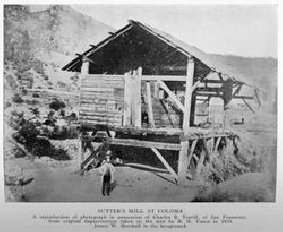
Sutter's Mill - 1850
49'ers Gold Miners
Early California Gusher
Sunset Gower Studios - Hollywood








